September 29, 2020 feature
A 3D-printed tensegrity structure for soft robotics applications
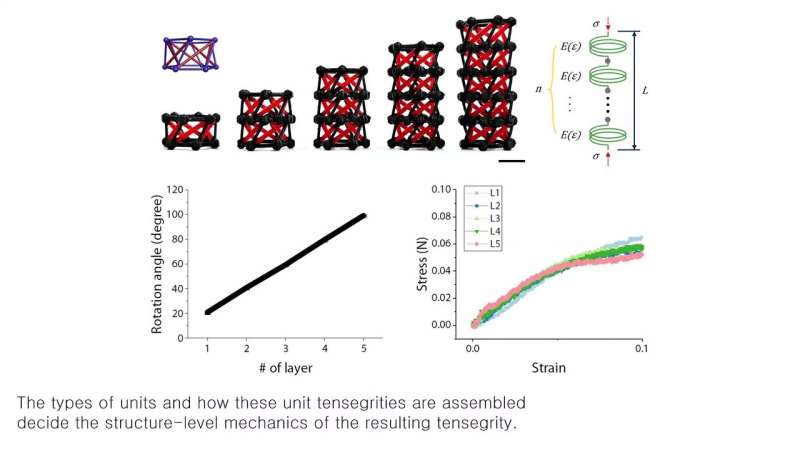
Tensegrity is a design principle that has often been applied by artists, architects and engineers to build a wide range of structures, including sculptures, frames and buildings. This principle essentially describes the dynamics that occur when a structure maintains its stability via a pervasive tensional force.
Over the past few decades, researchers have gathered evidence suggesting that tensegrity is a key design principle in nature, as it applies to a number of biological systems, including bodies, organs, cells and molecules. Tensegrity structures could thus also prove valuable for the development of bio-inspired robots, as it may enable the creation of systems that closely resemble those observed in living organisms.
Researchers at Ulsan National Institute of Science and Technology in South Korea have recently created a tensegrity-based programmable structure for soft robotics applications using 3-D printing techniques. This structure, presented in robotics.sciencemag.org/content/5/45/eaay9024" target="_blank">a paper published in Science Robotics, was fabricated using a simple and effective approach that combines the use of 3-D printing, smart materials and a strategy known as sacrificial molding.
"Soft robots need unique morphologies and mechanics that differ from those of conventional rigid robotics, as their materials and morphing mechanisms are different at various scales," Jiyun Kim, one of the researchers who carried out the study, told TechXplore. "Consequently, a structural approach is vital to devise a programmable and systematic design of unique and unusual morphology and mechanics of the overall structure of soft machine. In this work, we proposed a novel and advanced structural design methodology, adopting 'tensegrity' to offer an ample design space for the development of soft robotic architecture with various morphologies and mechanics."
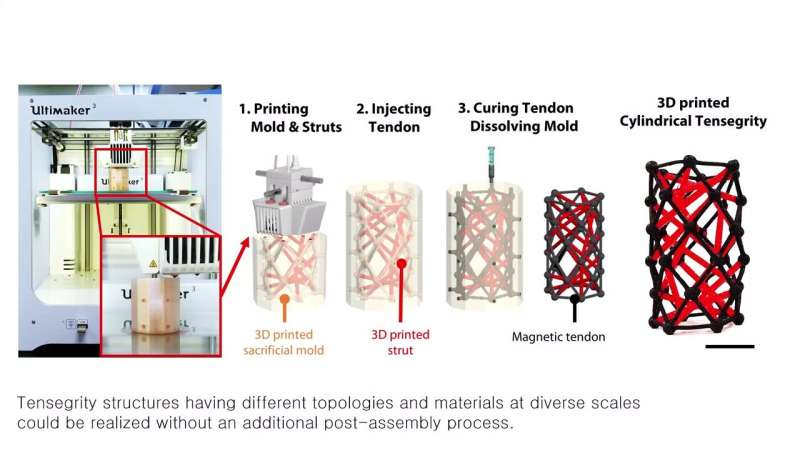
Over the past few years, Kim has been conducting extensive research exploring the potential of smart materials. During her studies, she observed that the programmed responses of these materials largely depended on their intrinsic properties. This dependence could significantly limit their scalability and applicability for the development of soft robotics systems.
Based on this observation, Kim sought to identify new structural approaches that could increase the systematic complexity and functional diversity of intelligent systems based on soft materials. She investigated the potential of several structural principles, including origami, but found that most of these approaches did not enable the creation of 3-D structures with complex shapes and mechanical properties.
"As I was conducting research into different structural principles, I got to know tensegrity, a 3-D structure that networks distinctively different materials providing both flexibility and integrity," Kim said. "We thought that tensegrity had unique potential for designing soft robotic architectures, because how these materials are networked decides the morphology and mechanical properties of the structure. Tensegrity could thus allow us to widen the design space of soft robotic structures and mechanics if we could identify an optimal manufacturing process."
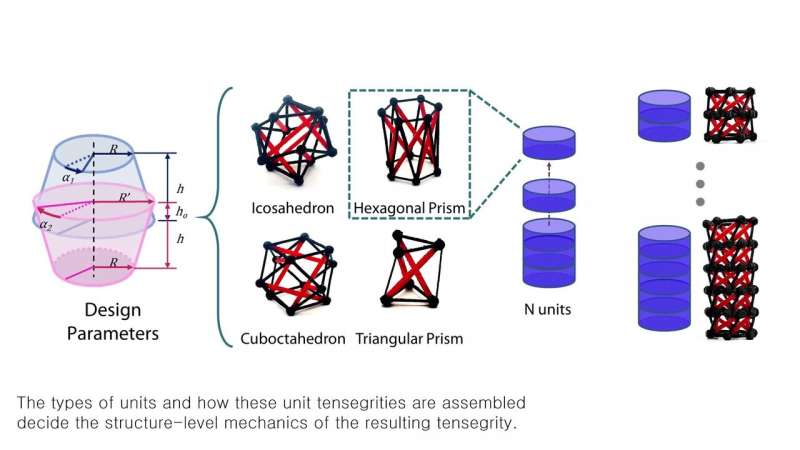
While tensegrity structures have proved to be promising for the development of soft robotics systems, manufacturing them can often be challenging, as it typically entails manually weaving materials together. To simplify this manufacturing process, Kim and her colleagues used a commercially available printer that has two nozzles and can thus automate the weaving process.
"The printer simultaneously printed a continuous internal channel network and isolated rigid struts within a sacrificial mold, and the smart materials were injected to fill the internal channels," Kim explained. "After the smart materials were solidified, the sacrificial mold was dissolved and the soft smart tendon network was seamlessly integrated with the rigid struts."
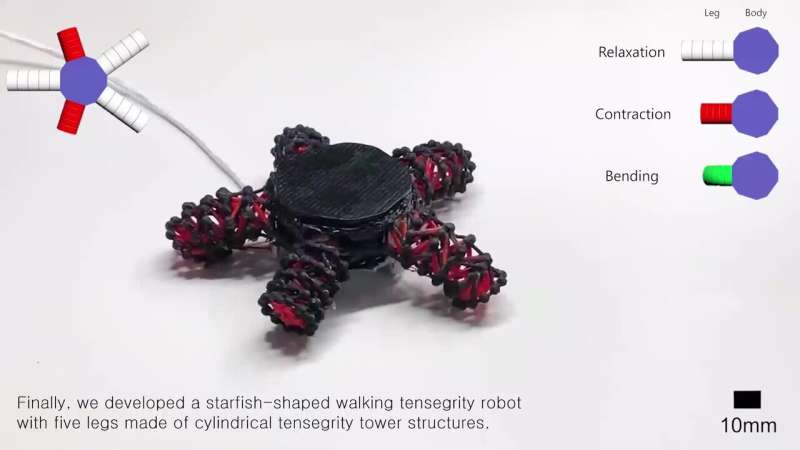
The 3-D printing approach used by the researchers enables the creation of complex tensegrity structures with different topologies (i.e., the patterns in which different parts are arranged) and of many different sizes. This results in the simple fabrication of structures with varying shapes and mechanical characteristics.
"We believe that tensegrity metamaterials enable the analytical and algorithmic design and operation of flexible structures, allowing for programmable complex behaviors in soft robotics systems," Kim said. "More importantly, advancing the development of tensegrity metamaterials could improve the actuation capability, adaptability, morphology and programmable mechanical properties of diverse soft robots."
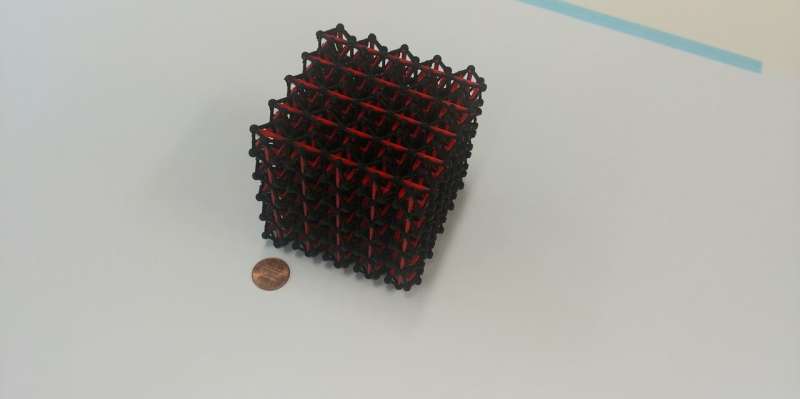
These researchers were among the first to propose a simple process to print complex 3-D tensegrity structures with different material compositions. They also demonstrated the potential of their design principle for fabricating various different robotics systems with a variety of shapes and mechanics. These systems can also have shape-changing capabilities and could be coupled with machine learning algorithms to tackle a broader range of tasks.
The study could serve as a guide for other research teams that are trying to design tensegrity structures for soft robots. In their next studies, the researchers plan to explore the potential of alternative structural principles for the development of shape-changing soft robots with complex mechanics.
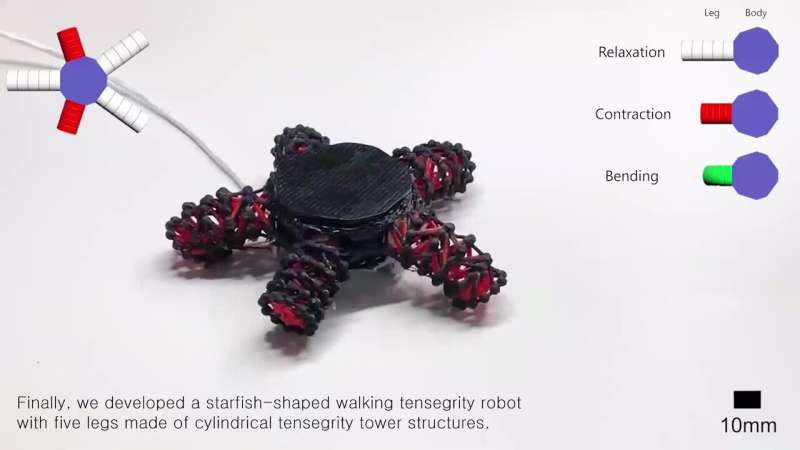
"New design methodologies and algorithmic operations of flexible structures will eventually lead to paradigm shifts in design, manufacturing, transformation and perception of future intelligent machines," Kim said. "In the years to come, we would like to create a more universal robotic platform that is capable of transforming into any shapes and mechanical properties, and that can be simply programmed and operated by users."
More information: 3D-printed programmable tensegrity for soft robotics. Science Robotics (2020). DOI: 10.1126/scirobotics.aay9024.
© 2020 Science X Network


















